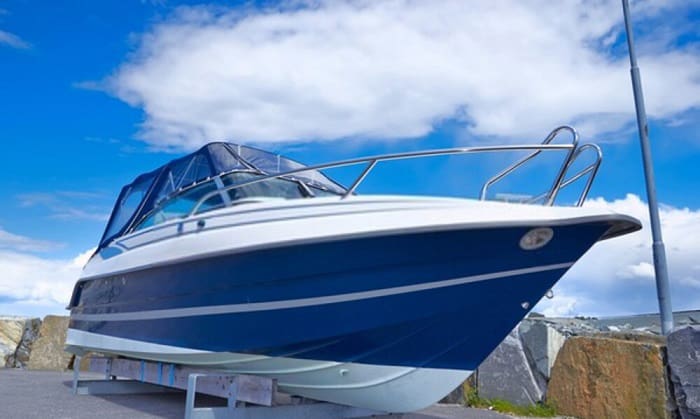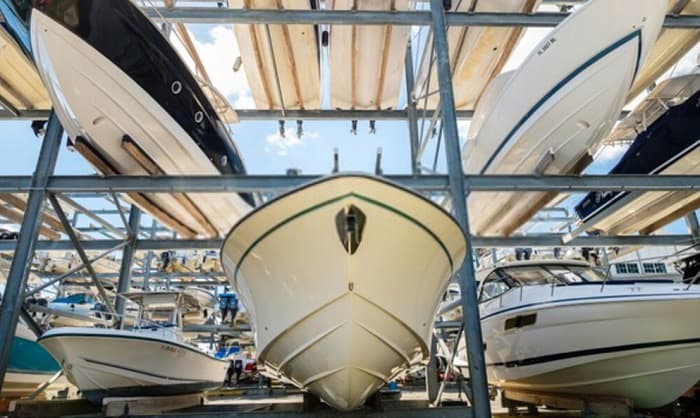Be-3 What Type of Boat Is Most Likely to Have a Planing Hull?

While studying about boats and ships, it is inevitable that yous discover it confusing to distinguish different types of boat hulls. Later all, they share many common features and fit with a lot of vessels. One of the most popular questions relating to this topic is, "What type of boat is most likely to have a planing hull?"
Boats, similar their hulls, are available in a multitude of forms and sizes. Regardless of their design, most hulls are intended to perform one among two things: expel water or glide on top of the wave, which is known as planing.
Yet, this is not all the data you need to know about planing or planing hull types. In this article, we will compile a proper caption for the title question as well as other knowledge related to planing hulls in particular and other gunkhole hull designs in general so you volition have an overview of this special boat component. We will cover the post-obit:
- What is a planing hull?
- The difference between deportation hull and planing hull
- Types of planing hulls and planing hull boats
- Planing hull'south size limits
Moreover, a listing of tips to distribute the boat'south book and further notices on traveling with planing hull vessels in real situations will be highlighted in this article. So, yous and other sailors can practice this procedure without too much difficulty. Continue reading to learn more!
Table of Contents
- What Is a Planing Hull
- The Difference Between Displacement Hull and Planing Hull
- Types of Planing Hulls and Planing Hull Boats
- 1. Round bottom planing hull
- 2. Flat bottom planing hull
- three. Deep V-shaped hull
- 4. Multi-hull
- v. Cathedral Hull
- Planing Hull's Size Limits
- Conclusion
What Is a Planing Hull

A planing hull is designed to generate positive pressure level distribution (elevator), which implies that information technology glides on its bow wave every bit well as reduces draft with speed. When a boat plans, the volume of hull within the water decreases, resulting in reduced drag.
Planing hulls offering a variety of shapes, the nearly typical is a V form together with a chine. This chine pushes the wave down, assisting with lift.
There are many models of V-shaped hulls, each with its own fix of handling features. A wide deep 5 hull typically provides a smoothen ride in surf, however information technology will have more effort to become moving, while a narrower shallow V may demand less power to travel just will not be as pleasant as the V hull when you lot run across loftier waves.
Flat lesser planing hulls, also known as cathedral hulls, have a larger horizontal surface expanse, and then they volition not be as pleasant in crude circumstances. Nonetheless, they perform a highly stable status while moving at moderate speed.
The Difference Betwixt Displacement Hull and Planing Hull

As I have mentioned above, a vessel with a planing hull may maneuver the waves regardless of its weight. To provide entrance to the shipping, information technology features a flat hull shape. The flatter the flooring, the improve information technology is in terms of usefulness!
Flatter hulls crave less power to achieve loftier speeds. All the same, there is a merchandise-off in controlling because flat hulls practice non perform well in choppy seas. To navigate crude waves, many planing boats feature shallow V-shaped hulls. This way of gunkhole hull is used in contemporary boats. Some boats even include "stepped" hulls for added lift.
On the other hand, a deportation hull may be identified past its rounded foundation or teardrop shape from the bow to stern. Information technology disperses the same corporeality of h2o as from the boat'due south capacity, as suggested past the name.
Therefore, the hull is constructive, equally seen on a range of cruise vessels, such every bit trawlers and certain sailboats. This hull design's speed is express by the multiplication of the waterline length's square root with ane.34. According to this estimate, a 64-foot boat is permitted to reach a peak speed of little more than than x knots.
Types of Planing Hulls and Planing Hull Boats
Since fishing boats are tiny yet power-driven, they frequently feature planing hulls. Most of the time, they surf the waves rather than plow it. Every bit a result, less gasoline is used. Still, the trip can be rougher and more unstable when they rebound on the water.
At that place are several varieties of planing hulls, each with its own set up of advantages and disadvantages, every bit described below:
ane. Round bottom planing hull
Although this form of hull and deportation hull share the same pattern, there are significant differences between the 2. While deportation hulls are mostly included in bigger boats, round bottom hulls are used in way smaller one, like kayaks or canoes. They provide a smooth ride and also swing back and along.
The goal of the rounded lesser hull is to permit boats to travel more smoothly on the waves at a slower speed. It also reduces the drag on the boats. The disadvantage is that it is unsteady and requires a balancer or a strong keel to prevent rolling.
ii. Flat lesser planing hull
This is common on relatively small, uncovered vessels with a low depth. Information technology's a style of hull that works well for angling in pools, lakes, and tranquillity rivers. Dinghy boats or rowboats are the greatest examples.
In calm water, boaters can rely on its steadiness. Have notice, though, of its wide bow, which creates a bumpy ride. It takes a lot of force to move it. Crafts with flat lesser tow are only available with low operation motors. Unfortunate scenarios may arise when these boats crash and roll during rapid bends.
3. Deep Five-shaped hull
The deep V-shaped hull is good for navigating choppy waves and venturing further across the shore. Information technology's a basic design, although certain producers may tweak it a little. It's what yous'll observe on fiberglass speed boats and watercraft.
At average speeds, a fishing vessel with such a deep V shape is simple to handle. The V department cuts through the waves, providing a smooth ride fifty-fifty in inclement atmospheric condition. Because of its modest typhoon, it's platonic for catching fish in minor rivers and streams.
Simply be cautious when making quick bends because it may roll or bank. This hull can travel at the aforementioned step as a flat-bottom hull, withal it takes more than horsepower.
iv. Multi-hull
Multi-hull trawlers feature more than one hull for planing equally well as displacement. The air pocket emerges in the centre of the hull, allowing these boats to easily have off.
This type of hull may be seen on pontoons or catamarans. They include a broad beam, which gives them tremendous stability and allows them to sail easily on the water. Have note of the fact that the propeller in this kind of boat is not entirely submerged.
Multi-hull boats demand a large pitch but also hold capabilities when traveling at higher top-end speeds. A big surface area is required when they rotate too.
5. Cathedral Hull
Cathedral hulls are designed based on the demand for a new model of altering tri-hulls in modern motorboats. Information technology'southward congenital for stability, with two or more hulls connected for increased breadth.
The hull's bow and stern have more surface area so expect a bumpier ride in turbulent weather. Due to the sheer hammering of the hulls, there are huge amounts of sprays also.
Planing Boat Hull Types | BoatUS
Planing Hull's Size Limits
Because it is said that planing hulls are best suited for smaller crafts, in that location needs to exist a size restriction. It's not a smart idea to upscale since cube quadratic police brings out flaws. Planing hull vessels typically differ in length from 20 to 24 meters.
The planing area and weight must be balanced. Whenever the length is doubled, the weight also increases past a factor of viii. In this scenario, the planing force per unit area simply raises four times and is therefore bereft for the weight.
Unfortunately, every planing hull has this drawback. It could never be a big ship since the planing pressure would be insufficient to sustain the increased weight.
Conclusion
After reading this post, I believe y'all have the answer to "What blazon of boat is most likely to take a planing hull?" Smaller vessels and angling boats like pontoon boats are the near suitable models with this kind of hull. The planing force will back up the weight of these water-skiing boats, making them easier to glide on the waves while traveling at high speeds.
This information is very useful, especially when yous are selecting a boat for angling. Nearly of all, we hope that the higher up information and guidelines can help you identify these types of planing hulls without too much try and buy the right boat to use.
Did yous savour the article? Practice you desire to add annihilation else? Please let me know and leave a annotate beneath.
Source: https://www.ridetheducksofseattle.com/type-of-boat-is-most-likely-to-have-a-planing-hull/
0 Response to "Be-3 What Type of Boat Is Most Likely to Have a Planing Hull?"
Post a Comment